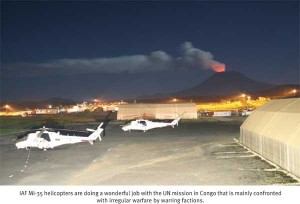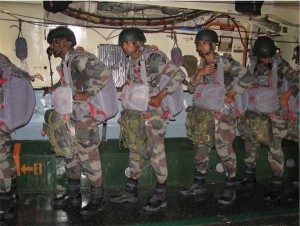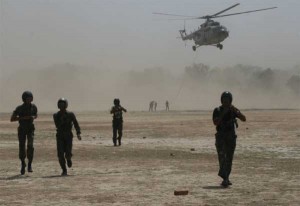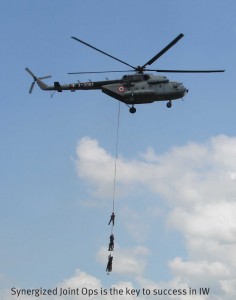“This is another type of war, new in its intensity, ancient in its origin — war by guerrillas, subversives, insurgents, terrorists, war by ambush instead of by combat; by infiltration, instead of aggression, seeking victory by eroding and exhausting the enemy instead of engaging him. It is a form of warfare uniquely adapted to what has been strangely called “wars of liberation,” to undermine the efforts of new and poor countries to maintain the freedom that they have finally achieved. It preys on economic unrest and ethnic conflicts. It requires in those situations where we must counter it … a whole new kind of strategy, a wholly different kind of force, and therefore a new and wholly different kind of military training.”1
President John F. Kennedy, 1962
India faces challenges like never before when it comes to tackling the lower end of the spectrum of warfare. The ongoing conflict with the Naxalites and the terror attacks in Mumbai are but grim reminders of this new reality. Preparing for the ‘big battle’ has always been the raison’ d’être of most militaries the world over. Even the militaries of USA and Israel, which have talked about this genre of warfare for decades, realized its all pervasive influence only after being rudely tested in Iraq and Lebanon.
The period after the Second World War saw economically progressive nations with large and powerful militaries develop an ability to effectively use military power as a potent tool of coercion in furtherance of state policy by engaging in coercive diplomacy. Before going further, there is a preliminary need to establish a linkage between the coercive capability of large powers and the emergence of Sub-Conventional or Irregular Warfare as a means of combating this capability.
During the Cold War, coercion became akin to a game with the US and the USSR testing their coercive capabilities across the globe using divergent tactics with different tools, but having similar objectives, viz expansion of influence and interests. Deterrence and coercion worked side by side and were complementary to one another.
The end of the Cold War saw the emergence of a deeply fragmented world that suddenly saw the emergence of numerous localised conflicts that were based on fundamental differences of race, religion and ethnicity.
Terrorists, insurgents and freedom fighters found remarkably new ways of fighting established states and combating the coercive capabilities of established nations or even coalitions with what is now commonly known as asymmetric warfare.
Thus, if one were to look across the spectrum of conflict — while powerful nations like the US, Russia, India and even smaller nations like Sri Lanka and Israel attempted to avoid ‘full scale’ war fighting methods to resolve conflicts and attempted to evolve coercive conflict resolution methods, their opponents excelled at what has emerged in recent times as techniques of ‘Sub Conventional and Irregular Warfare’ that eat away gradually at the fabric of the state.
Therefore, one can deduce that sub-conventional warfare has emerged as an effective counter to a larger nation’s ability to coerce, and the tools used are in stark contrast to the tools of conventional coercion, be it diplomatic or military.
Coercion & Irregular Warfare
If one were to look closely at the capabilities of both blocs during the cold war, all the main weapons of coercion used the medium of air, whether it was the Strategic Bomber or the ICBM. Some of the searching questions that need to be asked relate to the query that if air power played a pivotal role in coercion during that era, can it assume an equally important role in tackling today’s biggest threat to established and civilized society, viz Sub Conventional Warfare?
 The starting point would be to briefly examine the spectrum of conflict with specific reference to the dwindling possibility of conventional and limited wars, and arrive at the most probable scenarios for the future.
The starting point would be to briefly examine the spectrum of conflict with specific reference to the dwindling possibility of conventional and limited wars, and arrive at the most probable scenarios for the future.
The inability of smaller countries, entities and non-state actors to counter coercion with open force, and fight conventional wars have led to the emergence of war-fighting concepts with esoteric names like Sub-Conventional, Irregular, and Assymetric Warfare. Were these logical fallout or was it precipitated by history? In the post Cold War era, and at places even during the Cold War, failure of coercion invariably led to gradually escalated use of force.
Classic examples were the Vietnam conflict, the Indian peace keeping and enforcement operations in Sri Lanka, the Kargil Operation, and the Lebanon war of 2006. Air Power formed the primary tool for escalation and at places like Kargil and probably Sri Lanka, the much needed catalyst for conflict resolution too.
Some important questions that need to be asked and answered are — How successful has the application of Air Power been so far in combating Sub Conventional Warfare? What have been the restraining factors and limitations of Air Power in small wars? Has technology offered new perspectives and possibilities on the use of air power in small wars, sub conventional conflicts and irregular warfare?
Finally, if technology is exploited to the hilt can Air Power be exploited in a manner that the perpetrator of Sub Conventional Warfare be dragged to the negotiating table by causing unacceptable attrition and exerting exhausting pressure the way the Sri Lankan Air force is exerting on the LTTE? If so, has airpower not once again acted as an instrument of coercion, though this time not against established nations but against non state actors, terrorists and insurgents.
The stakes have recently been raised with the firing by the Naxalites on an IAF Mi-8 helicopter on 14 Nov 08 in the state of Chattisgarh, resulting in the death of a flight gunner and significant damage to the helicopter . The event is significant in the sense that the escalation has been initiated by non-state actors.
In the modern era of warfare the Israelis have been pioneers in the use of air and space assets to prosecute a campaign against non-state actors like the Hamas and Hezbollah without needlessly or prematurely committing ground forces. Though their strategy has met with limited success and evoked widespread international condemnation, it has certainly opened new vistas for the employment of air power at the lower end of the spectrum of conflict.
While a number of eminent academics and theorists like William Lind have unravelled the confusion that exists at the lower end of the spectrum of warfare, it is important to try and put it in simpler terms that is easily understandable by everyone. This warfare typically includes skirmishes between two adversaries prior to actual full scale conflict, insurgencies and proxy wars like the ones being faced by India in the north-eastern parts of the country and in J&K, wars of liberation based on ethnic divides as being waged by the Kurds and other non-state actors like the LTTE, and blatant acts of terrorism that are guided by religious extremism like the 9/11 attacks on the Twin Towers or the Mumbai attacks of 26/11.
After years of trying to fingerprint this genre of warfare, theorists have zeroed in on two terms that typecast these categories of waging conflict, viz. Sub-Conventional Warfare and Irregular Warfare. Both these terms reflect the flexibility and unpredictability with which these wars are fought, as also the difficulty for regular armed forces in formulating tactics and strategies to fight these battles.
Choosing the right weapons and training regular forces to think and train in a manner that contradicts age old tenets of war-fighting are other dilemmas that merit constant attention. Having tried to understand some typical facets of Sub-Conventional or Irregular warfare, it is now time to focus on the Naxalite movement that has been troubling India since the early sixties and now threatens her very fabric. Dissecting the movement is not within the purview of this article and it is assumed that the reader has a basic grasp of what Naxalism is and how it has assumed such a threatening posture.
Naxalism & Airpower
One of the reasons why naxalites2 have attacked the Indian para-military forces with impunity and great success is because they realize that domestic political compulsions have ensured that the armed forces are kept away from fighting an insurgency that is rapidly spreading in the hinterland of India.
 The armed forces in general have been chary of joining the fight against the naxals because they are already overstretched in J&K and the North-East. The IAF too is heavily committed in the same areas and does not have the resources to significantly influence operations against the naxalites. Another interesting aspect that has seldom been understood is the demographic nature of Naxalism vis-à-vis other insurgencies worldwide. In most other countries insurgencies have grown on geographical peripheries where insurgents have aspirations of independence and have had support from ethnically similar regions in neighbouring countries.
The armed forces in general have been chary of joining the fight against the naxals because they are already overstretched in J&K and the North-East. The IAF too is heavily committed in the same areas and does not have the resources to significantly influence operations against the naxalites. Another interesting aspect that has seldom been understood is the demographic nature of Naxalism vis-à-vis other insurgencies worldwide. In most other countries insurgencies have grown on geographical peripheries where insurgents have aspirations of independence and have had support from ethnically similar regions in neighbouring countries.
Typical examples are the Kurdish rebellion in Iraq & Turkey, the ethnic strife in the Balkans, the Chechen rebellion and to some extent, the Islamic unrest in the border province of Sinkiang in South-Eastern China.
In India too, the insurgency in the North East and the proxy war in J&K have received tacit support from meddlesome and ethnically similar neighbours. In such situations, it is not difficult to rationalize and motivate regular troops and airmen to fight the insurgencies as they visibly threaten national security. The Naxalite movement however is an insurgency that is spreading in the hinterland, with the same regions being represented in the armed forces. Whether this would be an impediment when it comes to having to join the fight against Naxalism is something that needs to be kept in mind by the govt and policy makers.
The stakes have recently been raised with the firing by the Naxalites on an IAF Mi-8 helicopter on 14 Nov 08 in the state of Chattisgarh3, resulting in the death of a flight gunner and significant damage to the helicopter . The event is significant in the sense that the escalation has been initiated by non-state actors just as the LTTE did during the ongoing Elam War-4 that is approaching a critical stage. The firing on the IAF Mi-8 helicopter indicates that the naxalite movement is willing to raise the stakes in its ongoing insurgency against the Union of India. This incident re-opens the debate on the use of offensive air power against a non-state actor within the confines of one’s own geographical boundaries.
 Numerous encounters in J&K between the security forces and terrorists have led to needless loss of the lives of security personnel because of the understandable caution with which they have gone about the encounters, particularly in relation to collateral damage and escalation control. Without getting to specific encounters in J&K, a few of which have had the potential to employ air power offensively with armed helicopters, excessive caution and restraint have resulted in the death of officers and men. These could have probably been avoided if armed helicopters were employed after ascertaining the low probability of collateral damage.
Numerous encounters in J&K between the security forces and terrorists have led to needless loss of the lives of security personnel because of the understandable caution with which they have gone about the encounters, particularly in relation to collateral damage and escalation control. Without getting to specific encounters in J&K, a few of which have had the potential to employ air power offensively with armed helicopters, excessive caution and restraint have resulted in the death of officers and men. These could have probably been avoided if armed helicopters were employed after ascertaining the low probability of collateral damage.
Typical examples of these have been the storming of Bakarwal huts4 by the Indian Army in the higher reaches of J&K where no civilian population lives for miles. The question we need to ask is that are we portraying the image of being a ‘soft state’ in our prosecution of war against the non-state actor? Are we also displaying a marked inability to synergize our capabilities against elements that threaten the legitimacy of the state?
If non-kinetic air power has to be used effectively and safely in a hostile environment within our own territory, it is essential that all elements of the state apparatus must support the mission from conception to execution. Without misinterpreting any facts, the IAF needs to be a trifle alarmed that the Naxals are now targeting them and initiate suitable measures to avoid recurrence of such incidents.
Case Study of A Typical Naxal Attack
It is important to study a typical Naxal attack and correlate it to a situation wherein air power assets were readily available for use in various roles, both supporting and offensive.5 On the night of 13 Nov 2005, a group of approximately one thousand naxalites converged onto the town of Jehanabad in Bihar, approximately 30 kms from the capital city of Patna. Their target was the district jail, which housed about 250 inmates including many of their leaders. Their timing was perfect, since most of the police force was deployed elsewhere in the state for election duties.
Numerous encounters in J&K had the potential to employ air power offensively with armed helicopters, excessive caution and restraint have resulted in the death of officers and men. These could have been avoided if armed helicopters were employed.
The police had about a day’s advance intelligence input of an imminent attack and had taken minimal precautionary measures as they underestimated their opponents. However, the sheer magnitude of attack surprised everyone and the prepared defences were rendered totally inadequate. After building up the force on the outskirts of the town, the naxalites launched a three-pronged simultaneous attack on the district jail, police station and the police lines.
Within an hour of the gun battle, the Naxalites were able to overrun the defences and free all the inmates of the jail. The attack left 15 policeman dead, numerous injured, besides the loss of weapons from the armoury at the police station. By daybreak, the naxalites had fled and melted into the nearby forests.
How could air power have helped in this situation? For this let’s go over a hypothetical situation wherein adequate airpower assets and a suitable command-control set up was available for the forces when this incident occurred. In time frame, let’s see how the situation would have developed. After having received an initial intelligence input of an imminent attack on 12 Dec 05 the civil administration could have alerted the crisis management group at the state capital, Patna.
The state in turn could have called for air assets, initially in the form of UAVs to step up surveillance in the area along with medium lift helicopters to transport specialized anti-insurgency para military forces into the area. All this could have been achieved on 12 Nov itself with a UAV control station in operation by the afternoon on Day 1 with UAVs operating from Patna airfield. Initial sorties could have been flown by the UAVs on 12th evening. These sorties would have established topographic details, likely entry points into the town, and identified vantage points for security forces in the expected area of operation. The morning of 13th Nov could have seen the identification and airlift of specialized para-military forces with limited night fighting capabilities into Patna. The forces would have been briefed and kept on a 30 minutes ‘hot standby’.
By the evening of 13th Nov, UAVs with live streaming capability via data links could have noticed Naxalite build up in the vicinity of Jehanabad. This would have been the trigger for insertion of troops around last light. The naxalite attack could have easily been repulsed with ambush positions cutting off escape routes. By midnight, majority of the insurgents would have either been killed or captured, inflicting a significant blow on the movement. A few escaping militants could have possibly been tracked to their hideouts opening the possibility of further strikes by para-military forces. This would have been the culmination of a successful anti-naxal operation in which air power could have been employed with telling effect in non-kinetic roles.
Airpower In Anti-terrorist Operations
Since the Entebbe operation in which Israeli commandoes were stealthily airlifted into Entebbe airfield, to the recent low scale slithering operations conducted by the Indian NSG during the Mumbai terror attacks and the Israeli strikes against Hamas leadership in Gaza, airpower has been employed against terrorists in all possible roles with mixed results. The impediments in employing offensive air power in anti-terrorist operations are many and a clear understanding of these are important for various tiers of state machinery that include bureaucracy, police, paramilitary forces and a wide cross-section of the military itself.
 Use of offensive airpower against terrorists in sparsely populated or under-developed terrain is a viable proposition with the US led coalition forces employing UCAVs, attack helicopters and fixed wing fighter aircraft in Afghanistan against the Taliban. Use of offensive or kinetic air power in urban terrain is a completely different ball game that is dictated purely by political constraints and compulsions coupled with humanitarian issues that relate to collateral damage.
Use of offensive airpower against terrorists in sparsely populated or under-developed terrain is a viable proposition with the US led coalition forces employing UCAVs, attack helicopters and fixed wing fighter aircraft in Afghanistan against the Taliban. Use of offensive or kinetic air power in urban terrain is a completely different ball game that is dictated purely by political constraints and compulsions coupled with humanitarian issues that relate to collateral damage.
The Israelis in Lebanon and Gaza, the US led coalition in Iraq and the Sri Lankan Airforce against the LTTE have used offensive airpower with varying degrees of success in urban terrain, but faced severe strictures from the international community for excessive collateral damage and loss to civilian life.
However, use of offensive airpower does have have a significant deterrence value and coercive effect on terrorist leadership and nations have to take a tough call on this based on national security imperatives.
For the time being however, nation states like India prefer to employ the non-kinetic or supporting roles of air power in anti-terrorist or even anti-insurgency operations that mainly include surveillance by UAVs, logistics and communication support by transport aircraft and helicopters and insertion of Special Forces into operations in hostile environment.
Summary
Employment of airpower in Irregular warfare is an inescapable requirement that needs to be looked at with renewed focus in the light of the recent Mumbai terror attacks, the increasing boldness of the Naxalites and the continued proxy war in J&K. There has to be a general realization that the lower end of the spectrum of warfare can be significantly influenced by intelligent and judicious use of air power in its various roles, both offensive and supporting.
Notes
- John F. Kennedy, Remarks to West Point graduating class, 6 Jun 1962.
- Naxalism is a term used to describe a Maoist insurgency that prevails in some states of India.
- Times of India,15 Nov 08
- Bakarwal huts are huts used by roving shepherds who set out from villages in the lower reaches of Kashmir in search of pastures for their flocks of sheep. These huts are generally abandoned in winter and are known to be used by infiltrating terrorists from Pak Occupied Kashmir as hiding and gathering places prior to spreading out into the lower reaches.
- Taken from a presentation made by Air Wing student officers of the 62nd Staff Course at DSSC Wellington in 2006 on ‘The Employment of Air Power in Small Wars’





Hi Arjun,
This is Sheilja … Dehradun….remember ?
Wanted to get in touch with you. …
Managed to get info about you through Google.
What and when is the right time to talk to you.
My mobile number : 98211 34771
Best Regards
Dr. Sheilja Singh